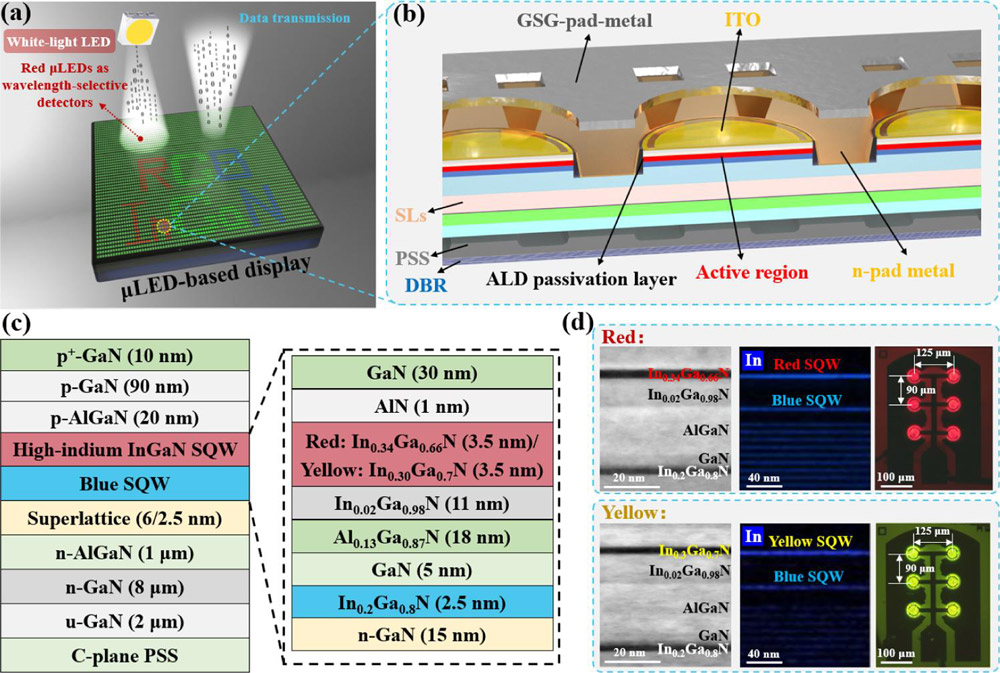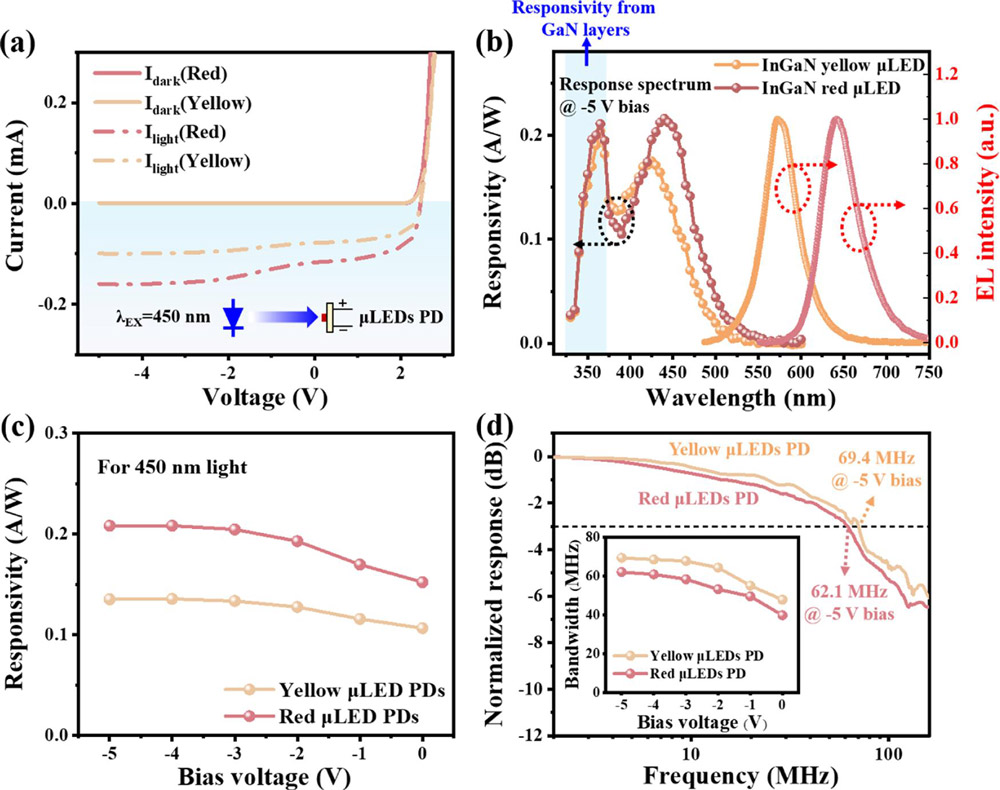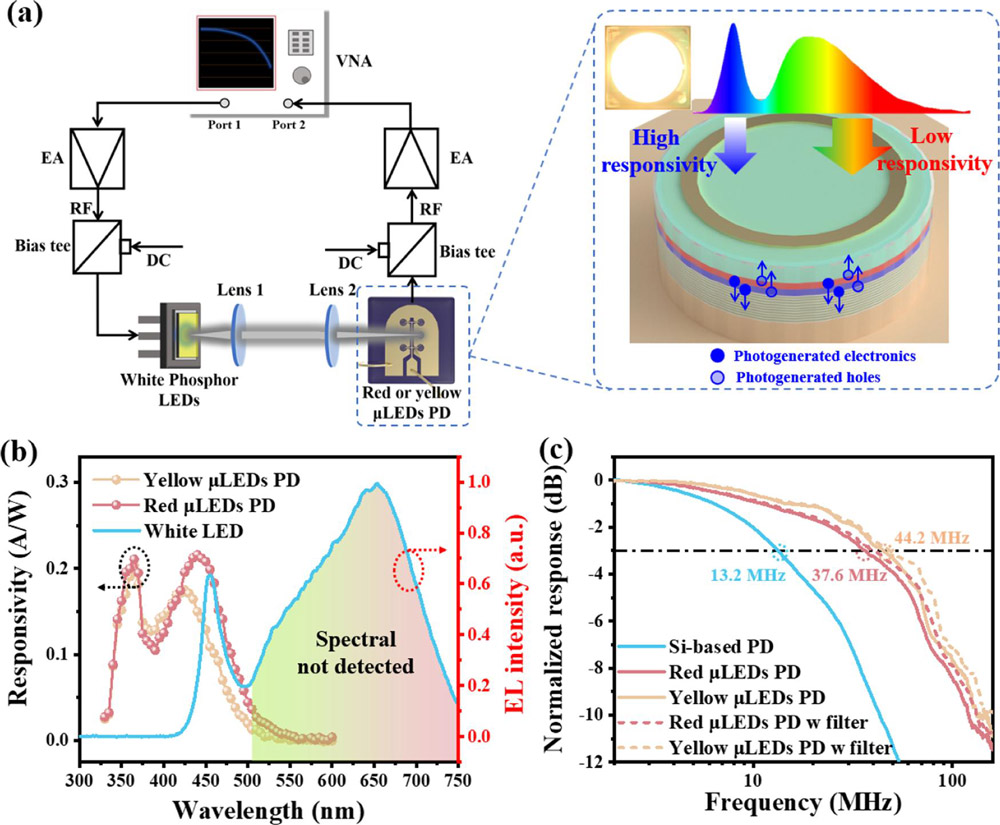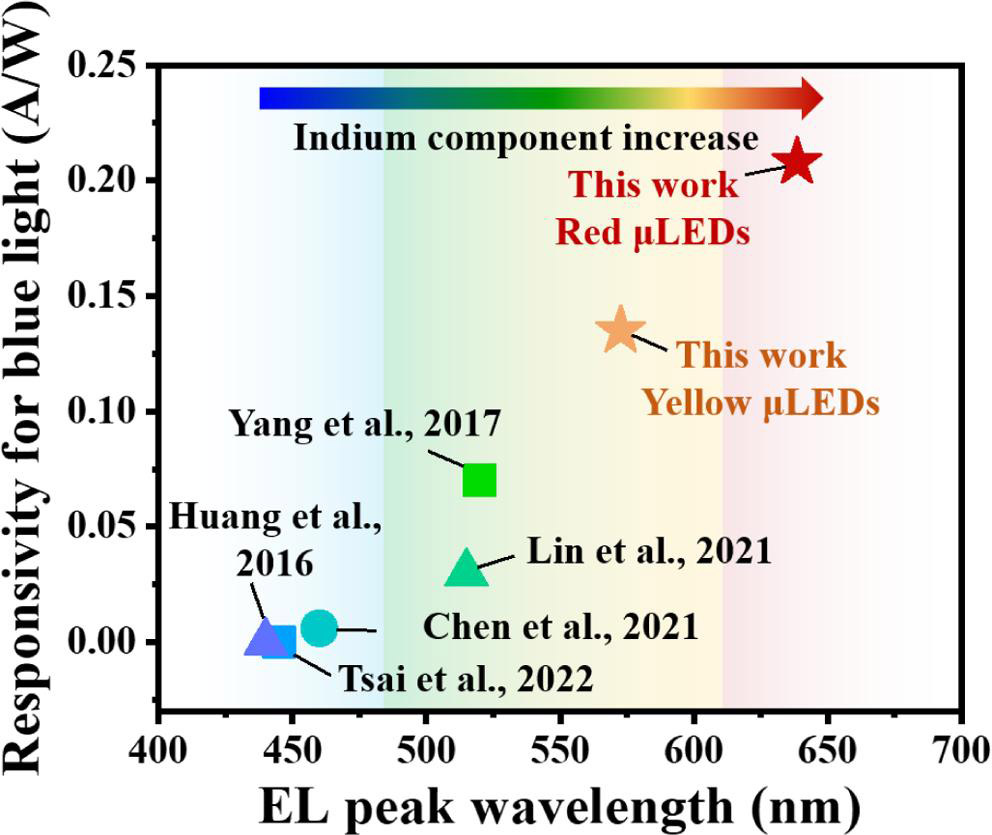News: LEDs
9 August 2024
Red/yellow InGaN micro-LED photodetectors for visual light communications
Researchers from Xiamen University in China and National Yang Ming Chiao Tung University in Taiwan report on the potential for using yellow and red indium gallium nitride (InGaN) micro light-emitting diodes (μLEDs) as both transmitters and receivers in visual light communication (VLC) systems [Tingwei Lu et al, ACS Photonics, published online, 25 July 2024].
A feature of the red/yellow μLEDs used as photodiode (PD) receivers was that they tended to naturally filter out longer visible wavelengths, responding only to the blue emissions from white LEDs based on yellow phosphors. The blue emissions can be modulated at fairly fast rates, unlike phosphor emissions, which tend to have a slow decay rate.
The researchers comment: “Compared with the silicon-based photodiodes commonly used in VLC systems, InGaN-based photodiodes have attracted academic interest owing to their advantages of low noise and high sensitivity.”
The research showed much higher responsivity for the studied red/yellow μLED photodiodes to blue light, relative to previous reports using shorter-wavelength μLED photodiodes.
The team adds: “Wavelength-selective photodetector applications further extend the versatility of long-wavelength μLEDs to provide technological complements to novel display and communication technologies.”
The researchers also point out that few previous studies have focused on the detection performance of long-wavelength μLEDs acting as photodiodes.
The researchers fabricated 2x3 parallel-connected red and yellow μLED arrays (Figure 1). The epitaxial material was grown on patterned sapphire substrates (PSSs). The devices used 50μm-diameter circular transparent indium tin oxide (ITO) electrodes with a view to enhancing current injection efficiency. The pitches between the μLEDs were 125μm in the horizontal direction and 90μm in the vertical direction. (Looking at diagrams in the paper, I suspect that horizontal refers to 2 columns (c), and the vertical to 3 rows (r), opposite to the rxc of matrix theory/linear algebra, for example.)

Figure 1: (a) Display, transmitter and wavelength-selective photodiodes multi-functional μLED applications. (b) Red and yellow μLED scheme and (c) epitaxial structure. (d) Transmission electron microscope (TEM) images, indium element energy-dispersive x-ray spectroscopy (EDS), and optical micrograph images.
The devices included a distributed Bragg reflector (DBR) applied to the backside of the PSS for increased luminescence efficiency. The sidewalls were passivated with atomic layer deposition (ALD) aluminium oxide (Al2O3).
The researchers comment: “The ALD passivation layer was effective in reducing the trapping of photogenerated carriers by sidewall defects, thus increasing the responsivity of the μLED photodiodes.”
The red and yellow μLED differed only in the long-wavelength indium content of the single InGaN quantum well (SQW). The SQW was grown on various combinations of GaN/AlGaN and a lower-indium-content InGaN blue SQW in an effort to manage the thermal and lattice mismatch stresses between the higher-indium-content InGaN, and the base GaN and PSS materials.
SQW devices tend to be less affected by stress problems such as the quantum-confined Stark effect (QCSE). The Stark effect refers to energy-level shifts due to applied electric fields. The stress management suppressed the polarization electric field that gives rise to the QCSE in the active region, improving both light emission and detection efficiency.
The current–voltage performance of the red and yellow μLEDs were 2.81V and 2.83V, respectively, at 20A/cm2 current density injection, the small difference being attributed to the narrower bandgap for red emission.
The light output powers reach around 2mW for the red device and 4mW for the yellow device at 2kA/cm2, at which point the performance is beginning to saturate. The team comments on the lower power for the red devices: “Compared to the yellow μLEDs, the red μLEDs are more severely affected by QCSE due to the higher indium content.”
The peak wavelengths of the μLEDs blue-shifted on increased current injection, 1–2000A/cm2: 642–559nm for the red, and 573–524nm for the yellow. Apropos of nothing, we note that the ‘red’ encroaches on the yellow range, and the ‘yellow’ ends up emitting green light.
The researchers comment: “For high-indium-content InGaN LEDs, the polarization-related electric field inside the QW is more severe, which leads to a more pronounced blue-shift.”
The team also measured the modulation performance of the devices under different current density. The −3dB bandwidths for the red and yellow μLEDs were, respectively, 143.3MHz and 162.5MHz at 100A/cm2, and 439.7MHz and 532.5MHz at 2000A/cm2.
Tests with 16-ary quadrature amplitude modulation (16-QAM) orthogonal frequency-division multiplex (OFDM) signal transmission showed bit-error rates (BERs) within the forward error correction (FEC) limit when operated at 570Mbit/s and 650Mbits/s (Mbps) for the red and yellow μLEDs, respectively.
The bit rates could be increased by increasing the current to 2000A/cm2, at the cost of the severe blue-shift red/yellow to yellow/green: 1.9Gbps and 2.4Gbps, respectively.

Figure 2: (a) Dark and 450nm laser diode (LD) illuminated current−voltage curves of red and yellow μLED photodiodes. (b) Responsivity and electroluminescence (EL) spectra. (c) Responsivity for 450nm light under different bias voltage. (d) Frequency response and calculated the bias-dependent receiving bandwidth.
In photodiode operation the devices showed two response peaks (Figure 2). The shortest wavelength peak at 360nm (ultraviolet) was attributed to absorption in the GaN layers. The longer wavelength peak was at 440nm for the red device and 425nm for the yellow device. The responsivities at the second peaks were 0.216A/W and 0.175A/W, respectively.
The researchers report further: “Red and yellow μLED photodiodes attained responsivities up to 0.208A/W and 0.135A/W for 450nm light, respectively, higher than those of the reported LED-based photodiodes.”
The response reduced as the absorption edges of the red/yellow InGaN SQWs was approached. This cut out responses to red and yellow light, enabling higher-bit-rate VLC via white LEDs, filtering out the yellow phosphor emissions and focusing on the direct blue LED emission.
The -3dB receiving bandwidths for the red and yellow μLED photodiodes from modulated 450nm laser diode light were 62.1MHz and 69.4MHz, respectively, at −5V bias.
The researchers also demonstrated a white VLC setup consisting of a white LED transmitter and the red/yellow μLED photodiodes (Figure 3). The spectrum of a typical white LED shows a narrow peak from the blue driving LED and a broad peak from a yellow phosphor that attempts to fill out other visible wavelengths to give an acceptable white illumination. The -3dB modulation bandwidths were 13.2MHz, 37.6MHz and 44.2MHz for the silicon-based and red/yellow μLED photodiodes, respectively. The InGaN-based devices had almost 3x the modulation performance over traditional silicon photodiodes.

Figure 3: (a) Bandwidth measurement setup for white light VLC system. (b) Response spectra of red/yellow μLED photodiodes overlaid with typical phosphor white LED EL emission. (c) Frequency responses measured by silicon- or long-wavelength μLED-based photodiodes.
White LED transmission/μLED photodiode reception data rates reached 1.2Gbps for the red device and 1.05Gbps for the yellow device.

Figure 4: Responsivity benchmarks of LED-based photodiodes for blue light versus EL peak wavelength.
The researchers compared their device response from 450nm blue light to that of other groups using photodiodes based on shorter-wavelength LEDs (Figure 4). The team comments: “To the best of our knowledge, this is the highest responsivity to blue light among reported LED-based photodetectors.”
The team is also to report shortly on a VLC system using wavelength division multiplexing (WDM) of InGaN blue, green and red μLED devices with a claimed 11.14Gbps aggregated data rate.
InGaN micro-LED photodetectors InGaN ALD Visual light communication systems
https://doi.org/10.1021/acsphotonics.4c00861
The author Mike Cooke is a freelance technology journalist who has worked in the semiconductor and advanced technology sectors since 1997.









